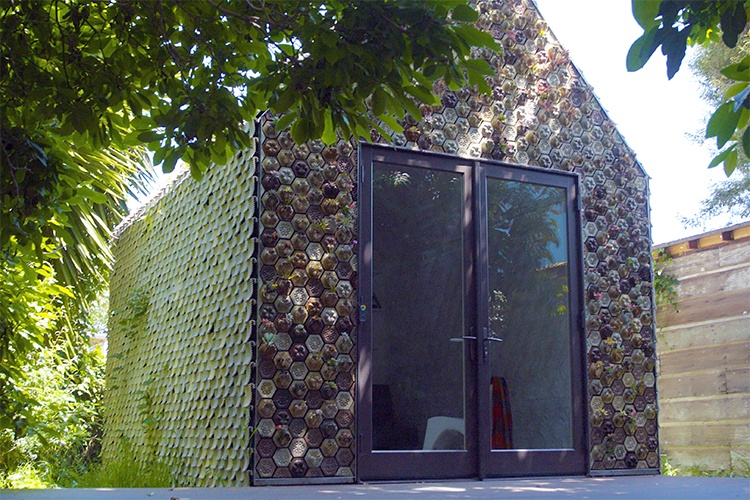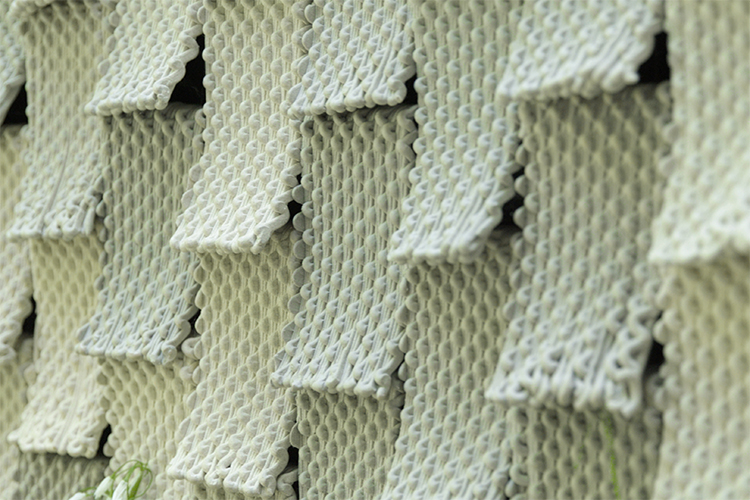A peek inside Ronald Rael’s 3D-printed ‘Cabin of Curiosities’
A first-of-its-kind creation, the 3D-printed building is water-tight, weather-proof and livable

July 19, 2018
UC Berkeley Associate Professor of Architecture Ronald Rael’s “Cabin of Curiosities” is a livable, water-tight structure in Oakland that was unveiled in May 2018. With succulents growing off the exterior walls and a translucent interior, the cabin catches the eye and inspires wonder. What makes the structure unique, however, is not its beauty, but the fact that nearly every element of the cabin was constructed out of 3D-printed materials.
Built with the help of his partner, Virginia San Fratello of San Jose State University, several students and alumni from Berkeley’s College of Environmental Design, and supported by Berkeley’s Bakar Fellowship, the cabin makes use of “upcycled” materials by repurposing discarded items like grape skins, salt, cement and sawdust and turning them into building materials to create a functional, sustainable living space.
This March, Rael’s cabin was named the winner of the 2018 3D Pioneers Challenge, an international additive manufacturing technologies competition.
Berkeley News caught up with Rael to talk about constructing the cabin, the benefits of upcycled materials and the future of 3D-printed buildings.
Berkeley News: Where did you get the idea to construct the Cabin of Curiosities?

Ron Rael and Virginia San Fratello at the cabin (UC Berkeley photo by Stephen McNally)
Ronald Rael: After I was awarded the Bakar Fellowship in 2015, I was interested in embarking on the endeavor of using all of these technologies that we’d been experimenting with to demonstrate that it was in fact possible to produce a weather-tight, weather-proof, livable, 3D-printed structure. I took all that research and aggregated it into the interior, the exterior, and allowed this project to be in a place where we could test the longevity of these materials and how they respond to weather.
In the end, this was the first time that we’ve assembled all of these elements to make something that is fundamentally a building, a piece of architecture. It has an interior, an exterior and is occupiable.
How long did it take to construct?
It took about a year, but of course that’s not a normal construction schedule. I was finding time to work on it in between classes. It wouldn’t take a year if we were working on this solely or as a private entity.
Measures were recently passed in the East Bay that loosened restrictions on the construction of secondary housing units and backyard cottages as the Bay Area continues to struggle with providing abundant affordable housing. What role can 3D-printed buildings play in alleviating housing issues in the Bay Area?
I can’t claim that 3D materials alone will resolve the issue, but what is important here is that relaxation of building policies allows for experimentation that pushes the technology forward much more quickly.
The issue of housing is multifaceted — it’s a socioeconomic problem, it’s a political problem — so 3D printing alone isn’t going to be enough to fix it. But I do think that labor is expensive in the Bay Area, and if you can put to task machines that address the problem of labor, then you’re helping to solve the problem.
Low-cost housing requires low-cost materials and labor. If we can use materials from the waste stream, materials that are free or inexpensive, and use manufacturing techniques like robotics to produce architecture, I think that’s one way to address some of these issues.

(UC Berkeley photo by Stephen McNally)
Upcycled materials are used extensively in the cabin. How does upcycling contribute to the sustainability of these kinds of projects?
I would say that upcycling materials isn’t anything new in the construction industry. Much of the building materials that are in use right now — materials like particle boards that are made out of wood chips leftover at sawmills, medium-density fiberboards made out of sawdust and other engineered lumber —are already made out of upcycled materials. The difference is all of those materials are made in such a way that they are standardized and homogenous and mass-produced. I think one of the advantages of 3D printing is that it can be customized and particularized in such a way that challenges or disrupts that tradition.
As for sustainability, a number of the materials that we used were readily available because companies want to know what to do with these materials. Whether it’s sawdust or grape skins or clay — these are materials that are very inexpensive, if not free, so access to them is relatively easy.
How should we be thinking about scalability of these kinds of projects? What are the limits of 3D-printed construction?

(UC Berkeley photo by Stephen McNally)
I think the question of scalability for me is answered not by building bigger and bigger printers, but rather by using multiple printers to produce smaller components. Scalability happens not by managing a behemoth printer that’s larger than the building itself, but in finding ways to manage the production of many different complex parts through a farm of printers. For us, that’s an interesting way and a different model to grow from. Scalability is accomplished through quantity not size. On this project, for example, we used between 14 to 25 printers.
Do you feel like using 3D-printed materials in construction opens up new possibilities for creativity in design?
We as humans respond to components of the building in different ways. We want soft parts of the building, we want surfaces that are opaque and translucent. We want to identify culturally with different parts of the building and the larger ecology. If the future of 3D printing is only concrete cells, then it doesn’t sound so exciting. What is more exciting for me is inserting a level of craft into that process that we can relate to. To me, that’s really important.
We’re also not just talking about aesthetics, which I think is a common misconception about architects. We now have the ability to create different forms of material output, different shapes, that do different things. Whether it’s collecting water or built-in insulation, you now can produce shapes with undercuts that saw blades or casting wouldn’t be able to facilitate very easily. I think there are a lot of different opportunities with this method of manufacturing that aren’t as easy to accomplish through traditional means.
[image360 image_id=”69043″ caption=”Drag around the image for a 360-degree view inside the Cabin of Curiosities. 360 image by Stephen McNally”]
Such as?
I think much of the learning is in the mistakes. What’s robust about this process is that the mistakes can be accommodated through the ability to customize immediately. We didn’t think through every element of construction, as is impossible to do in any building, but whenever we made a mistake — if we fell short a couple inches in part of the design, for example — we were able to design customized pieces that accommodated for those mistakes. There wasn’t a search at the store to buy something to fill in that gap or going to a custom craftsman who could measure and fit something into a strange shape to fix our mistakes. Instead, we could design it ourselves and be able to prototype it in just a few minutes.
What does the future look like now that you know that 3D-printing is capable of creating water-tight, viable structures?
I think there are lots of different paths that are on the horizon, but one thing that is very clear to me is that builders and architects are going to be specifying and working with additive manufacturing methods in the future. I don’t think there’s any question about that. The larger question is, in what ways will they do so?
The approach that I’m taking focuses on buildings that can be componentized — which I find to be both exciting and pragmatic. Exciting because it completely upends the way we think about finishes and the parts of the building that we have the most relationship with. We look at our walls, we touch our walls, our walls shed water in different ways, they play with the light in different ways, they buffer sounds, they’re translucent, they’re opaque, they have different colors. The ability to explore that through 3D-printing is very exciting.
In terms of pragmatics and manufacturing, if you’re 3D printing an entire building and the 3D printer breaks or stops, then everything stops. But if you’re printing components of building with a number of printers, then while one printer is down you can continue to print with other printers and nothing stops. The delivery of materials can be on time or done overnight, and they can be produced on site, which gives a lot of flexibility and customization of smaller parts verses the mass production of larger houses.

(UC Berkeley photo by Stephen McNally)